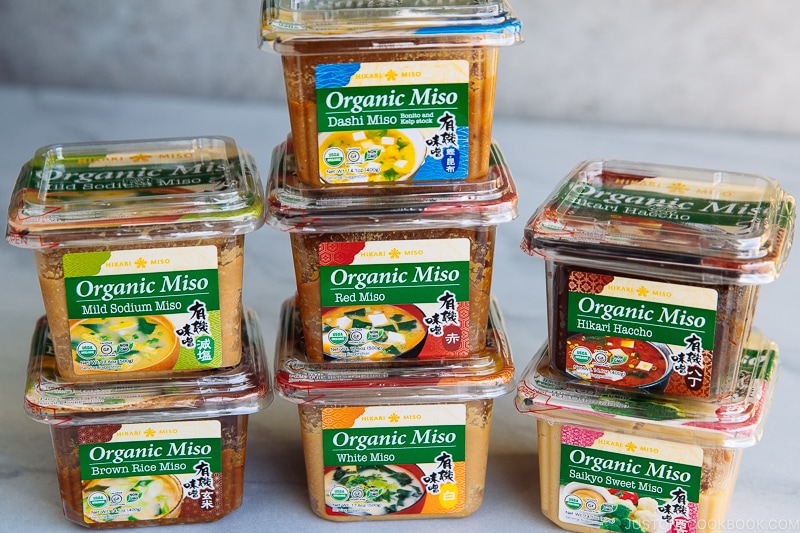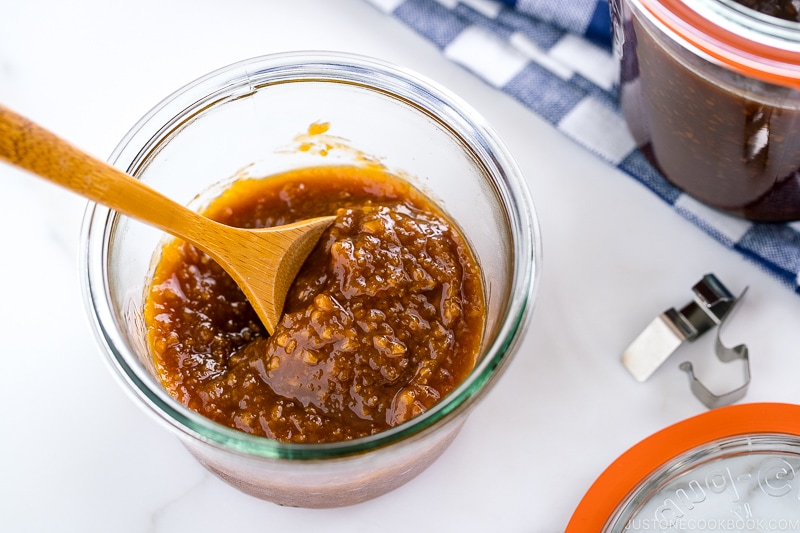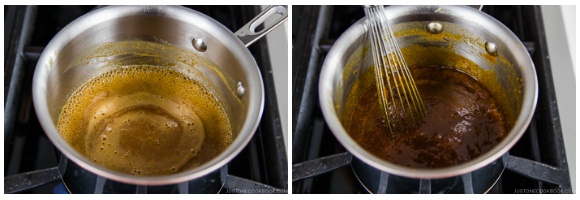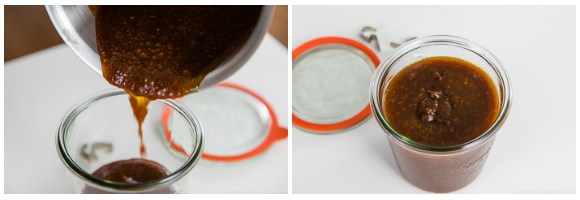Use my versatile All-Purpose Miso Sauce to make glazes, marinades, dressings, and dipping sauces. This sweet and savory sauce is the secret to many of your favorite Japanese dishes. Add it to any protein or vegetable for a boost of authentic umami flavor. This vegan-friendly sauce is super easy to put together with just four ingredients.

It’s always good to have homemade sauces around in your kitchen so you don’t end up with the store-bought stuff. Not only you have complete control over the ingredients, but a homemade sauce always tastes so much better. Today I’m sharing my secret magic sauce: the brilliant All-Purpose Miso Sauce.
Whether it is to add a little depth or complexity, this miso sauce never fails to jazz up a dish whenever something is amiss. Just like a reliable friend you can count on anytime!
The Best Miso Sauce
5 reasons to love this sauce:
- It’s full of authentic Japanese flavor. The sauce is the guarded secret to many of your favorite Japanese dishes.
- Super easy to put together & only 4 simple ingredients needed!
- Long shelf life. Make once and store well in the fridge for up to 2 months.
- Its ability to transform. You can get a whole variety of homemade sauce with varying flavors by using different miso. Mild, sweet or pungent – you decide.
- Unlike bottled seasoning sauces, this homemade sauce is free of processed ingredients and MSG (monosodium glutamate).

3 Things to Know When Making All-Purpose Miso Sauce
1. Saltiness varies based on the miso brand/type
If you’re using a different brand or type of miso, keep in mind that the saltiness level may differ from my recipe. So adjust accordingly.
2. Different types of miso yield different flavors
Miso can be made of rice, barley, soybean, or koji, and each one has different strengths and depth. Just like saltiness, if you’re using a different type of miso, your homemade miso sauce may not taste exactly like mine. It also means you can literally make a variety of this sauce by using different types of miso.
3. Miso burns easily
Miso itself burns easily while cooking, but it gets even more susceptible when you include mirin and/or sugar. Be sure to keep a close eye of the pot. Stay around to scrape the bottom of the pot and keep stirring.

Recipe Ideas with All-Purpose Miso Sauce
- Marinade: Use different proteins including fish, chicken, pork, beef, and tofu. Cook in the foil, oven or pan fry.
- Stir Fry: Add just a tablespoon or two of the miso sauce to the stir-fry dishes.
- Simmered Dishes (Nimono): Simmer root vegetables and protein with miso sauce.
- Dipping Sauce: for your steamed vegetables, hot pot, or simply, fresh cucumber.
- Dressing: Coat with all kinds of vegetables and add them to the salad dressing base.
Sweet, savory, versatile, and full of umami, that’s what makes this All-Purpose Miso Sauce so brilliant. I know you’d have fun integrating the sauce into more of your cooking.
Recipe Ideas:

Wish to learn more about Japanese cooking? Sign up for our free newsletter to receive cooking tips & recipe updates! And stay in touch with me on Facebook, Pinterest, YouTube, and Instagram.

All-Purpose Miso Sauce
Instructions
- Gather all the ingredients.

- Add 1 cup miso, 1 cup mirin, ½ cup sake, and 2 Tbsp sugar to a small saucepan.

- Whisk it all together. Set the pot on the stove and bring the sauce to a boil over medium heat.

- Once bubbling, reduce the heat to low. Keep stirring and scraping the bottom of the pot to prevent the sauce from burning. Simmer for 20–30 minutes until thickened. Your miso sauce is now ready to use.

To Serve
- Enjoy this All-Purpose Miso Sauce as a marinade for protein like chicken thighs in my Miso Chicken recipe. You can also use it to make my delicious Tahini Miso Dressing to serve with all kinds of vegetables and salads like my Roasted Cauliflower Kale Salad.

To Store
- Transfer the sauce to an airtight container and let it cool completely. Close the lid and store in the refrigerator for up to 2 months.

















I wanted to make this sauce for the miso chicken but sadly I only had a third of the miso required. In a complete experiment I have substituted a 1/3 of the miso with gochujang, I know its not the same and will add a completely different flavour but I think it will be pretty good. Have only made the sauce so far and haven’t used it as a marinade yet but tasting it on its own it is quite nice and a little spicy so I am looking forward to it!
Hi Mandy! That sounds actually delicious! I think it’s fun to experiment – I use different miso to make this sauce too, and even with different miso, the sauce is different so we never get bored. Thanks for your idea of gochujang!
Hi Nami!
I cooked this sauce yesterday exactly as you instructed, yielded such a lovely smell throughout the house! Thank you for the recipe!
Apart from marinade and dipping sauce for your miso chicken recipe, I have just a few questions:
1) Can I use this sauce as stir fry sauce for veggies or meat? Would you point me to your recipes with uses for this sauce?
2) How do I use this sauce with salmon?
3) I did a taste after it was simmered. Umami and salty, must I dilute it with water before using it?
Thank you! Hope you don’t have to exert too much answering my questions, and get well soon! We missed you.
Hi CY! Thank you so much for trying this recipe!
1) You can add the seasoning toward the end but the miso burns so easily that it is not meant to stir fry together for a long time. The ingredients are cooked through by the time you add miso.
2) I’d marinate in the sauce or steam with the sauce (check my Salmon in Foil recipe and use this miso)
3) Depends on how you use it. Because miso burns fast, we don’t leave the marinade on top of ingredients, like salmon or cod and we have to remove them completely. You can also use a small amount to season, just like miso.
Hi Nami
Thanks for your yummy recipes. I have cooked your Japanese Hamburger twice and my family just love it so much!
For this All-purpose Miso Sauce, what can I replace with Sake? Thanks and wish you a speedy recovery from your recent shoulder issue.
Hi Alice! I’m so happy to hear your family enjoy hambagu! 🙂 You can replace it with Chinese rice wine or dry sherry… you can add water but missing the umami or flavors from sake.
I’m going to try and make miso sauce and miso chicken today.
Hi Faiza! Hope you enjoy the recipe! 🙂
Hi, I’m wondering what I can use to replace the sake? I’m testing a recipe for kids and I can’t cook with alcohol for a school district.
Thank you 🙂
Hi Jessica! When we use sake in cooking, all the alcohol is evaporated through cooking and we’re after the slightly sweet liquid with umami. It’s different from flavorless water, but I guess that’s the closest substitute… 🙂
I only have white miso. Would it still work?
Hi Jos! Sure, you can use any miso you like. Each sauce will taste differently. I recommend tasting to adjust as each miso has different saltiness etc. 🙂
This sounds delicious. I’m already pushing my allergy luck with miso, what do you suggest to substitute for sake? I’m allergic to alcohol, which I realize is also risky when using miso.
Hi Teri! Maybe this recipe may not be for you. Mirin and Sake both contain alcohol. I am a bit allergic to alcohol too (I get itchy and my skin reacts). For cooking, we always let the alcohol evaporate so we do not contain alcohol. It evaporates after cooking for a few minutes. If that works, then you should be okay with this recipe. We use sake and mirin for recipes and always make sure it’s been evaporated before feeding the kids.
Absolutely at the top of our list for glaze/marinates. We use it in several different ways with meat, vegetables and rice. Tomokuteki & Oishi!!!!!!
Hi Cheryl! Yokatta! Thanks so much for your kind feedback! I’m so happy you like this All-Purpose Miso Sauce. Have you tried Negi Miso Sauce? That’s probably my favorite! 🙂
Seems good so far. I made this recipe to make the miso chicken. I went for the full 30 min of simmering and I noticed by the end the sauce barely bubbled which I took to mean all the water was gone. I ended up with just under two cups of sauce. The taste seems okay but I’m waiting to see how it all comes together when I make the chicken. Would love to know how much sauce this recipe makes once you are done thickening. Also I loved the pictures as a guide in this recipe.
Hi MK! Thank you for trying this recipe! I hope you enjoy this sauce with chicken. Hmm…I only got 1 cup at the end as you see in the recipe. 🙂
I can’t wait to try this recipe, it sounds so versatile and tasty. I’m curious about one thing though. I’ve read that miso shouldn’t be boiled and you should add miso at the end of a recipe. I’m not sure why, but am wondering how it effects the miso for this recipe where you need to boil it down to a thicker consistency with the other ingredients.
Hi Tricia! Yes, that’s true – for the deliciate recipes like miso soup, you do not want to boil it. The fragrance and taste of miso will disappear when you boil it. So it’s best not to boil it. However, certain dishes like simmered dishes, hot pot dishes, miso flavored dishes, and sauce like this… it’s inevitable not to boil the food. So you can’t avoid it. 🙂 It really depends on dishes. Hope this answer helps!
Hi Nami, so since it’s inevitable not to boil miso for this sauce, would this sauce won’t have that miso taste after we’re cooking it?
Hi Jos! Yes, it’s true that we should not let the miso boil, especially for miso soup, but it’s also true that we have a lot of miso recipes in Japan that require simmering/braising, and it’s definitely “boiling”. Miso soup is more delicate and miso being the main flavor you enjoy. However, when the ingredients are cooked with miso, we can’t focus on not letting miso boil… that would be impossible! We have Miso Nikomi Udon which requires cooking ingredients in boiling/simmering miso broth, and this sauce which requires reduction. Hope this makes sense!
[…] All-Purpose Miso Sauce […]
I’m trying to find out what kind of Miso to use & (make a Sauce) to add To chicken broth for a Spicy Miso Brith with Book Chou, carrots, cabbage & Salmon Soup? I had this Dish at a Restaurant & I’m trying to duplicate it! It was Delicious & Healthy (perfect for Keto Diet)!! However, I don’t know “Everything” the Chef put in the sauce to add to the Chicken Broth!! I Need Help!! First.. with “What Kind” Of Miso Paste to get??!! As I see there are Several Types!! Yikes!!
Hi Alyce! Yeah… miso has so many kinds (in Japan, even MORE!)… Replicating the taste relies on the type of miso they use.
https://www.justonecookbook.com/miso/
I like Hikari Miso “Kodawattemasu”, if you can find this miso… It’s a good start. 🙂
Hi Nami, can I freeze this finished miso sauce if I can’t use it up?
Hi Christina! Yes you can. 🙂
[…] All-Purpose Miso Sauce […]
Hello,
This is a general question about miso: how long can you keep it ?
Thanks in advance,
Miya
Hi Miya! If you are asking about the miso itself, it can be kept in the fridge for up to a year. If you’re talking about this all-purpose miso sauce, then about 2 months. 🙂